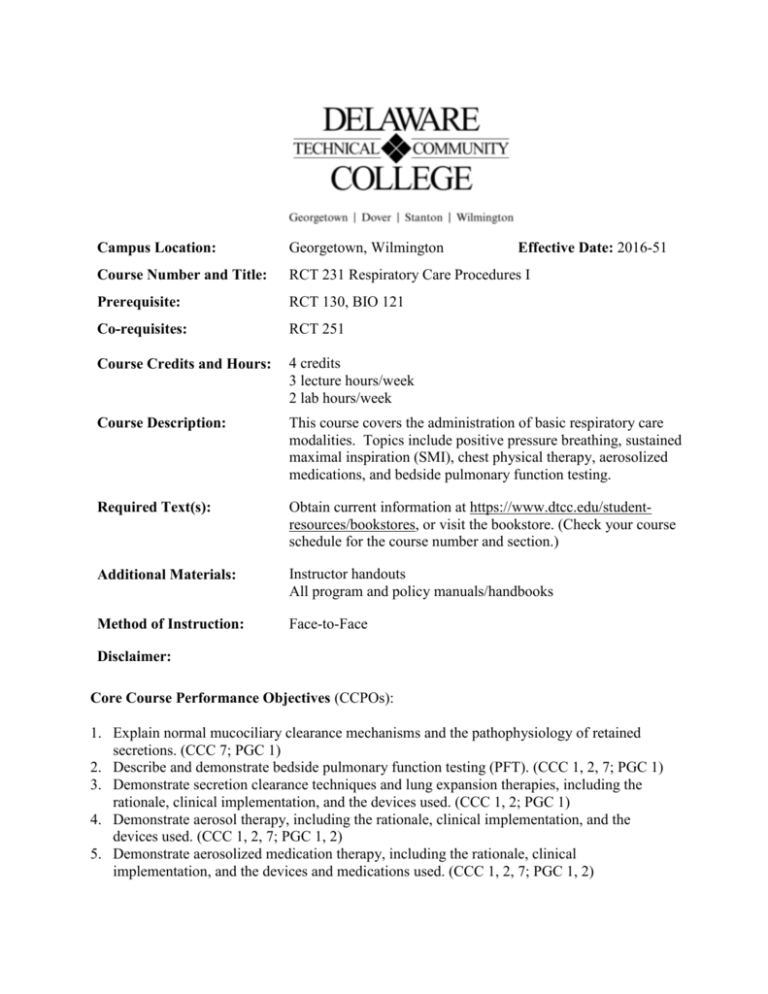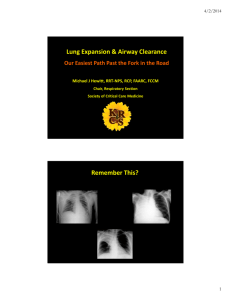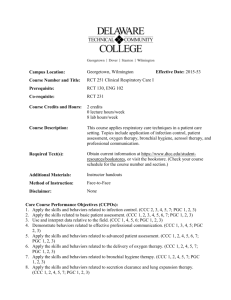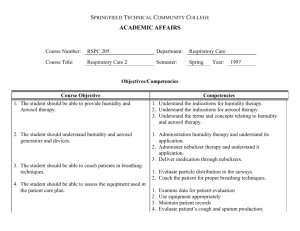RCT 231 201651 - E
advertisement

Campus Location: Georgetown, Wilmington Effective Date: 2016-51 Course Number and Title: RCT 231 Respiratory Care Procedures I Prerequisite: RCT 130, BIO 121 Co-requisites: RCT 251 Course Credits and Hours: 4 credits 3 lecture hours/week 2 lab hours/week Course Description: This course covers the administration of basic respiratory care modalities. Topics include positive pressure breathing, sustained maximal inspiration (SMI), chest physical therapy, aerosolized medications, and bedside pulmonary function testing. Required Text(s): Obtain current information at https://www.dtcc.edu/studentresources/bookstores, or visit the bookstore. (Check your course schedule for the course number and section.) Additional Materials: Instructor handouts All program and policy manuals/handbooks Method of Instruction: Face-to-Face Disclaimer: Core Course Performance Objectives (CCPOs): 1. Explain normal mucociliary clearance mechanisms and the pathophysiology of retained secretions. (CCC 7; PGC 1) 2. Describe and demonstrate bedside pulmonary function testing (PFT). (CCC 1, 2, 7; PGC 1) 3. Demonstrate secretion clearance techniques and lung expansion therapies, including the rationale, clinical implementation, and the devices used. (CCC 1, 2; PGC 1) 4. Demonstrate aerosol therapy, including the rationale, clinical implementation, and the devices used. (CCC 1, 2, 7; PGC 1, 2) 5. Demonstrate aerosolized medication therapy, including the rationale, clinical implementation, and the devices and medications used. (CCC 1, 2, 7; PGC 1, 2) 6. Demonstrate positive pressure breathing, adjuncts to bronchial hygiene therapy, secretion clearance, and lung expansion, including the rationale, clinical implementation, and the devices used. (CCC 1, 2; PGC 1) 7. Demonstrate chest physical therapy (CPT) and adjunctive equipment, including the rationale, clinical implementation, and the devices used. (CCC 1, 2; PGC 1) See Core Curriculum Competencies and Program Graduate Competencies at the end of the syllabus. CCPOs are linked to every competency they develop. Measurable Performance Objectives (MPOs): Upon completion of this course, the student will: 1. Explain normal mucociliary clearance mechanisms and the pathophysiology of retained secretions. 1.1 Describe normal mucociliary clearance mechanisms. 1.2 Delineate the pathophysiology of retained secretions. 1.3 Classify common etiologies and clinical manifestations of retained secretions. 2. Describe and demonstrate bedside pulmonary function testing (PFT). 2.1 Explain the rationale for bedside PFT. 2.2 Differentiate the structure, function, and limitations of selected bedside PFT devices. 2.3 Identify and explain the following terms: a. Forced vital capacity (FVC) b. Forced expiratory volume timed (FEV(T)) c. Minute volume (MV) d. Negative inspiratory force (NIF) e. Peak flow (PF) f. Slow vital capacity (SVC) 2.4 Explain the technique and clinical usefulness of each of the following bedside assessments: a. FVC b. SVC c. FEV(T) d. PF e. MV f. NIF g. VT/VC ratio h. Tidal volume (VT) i. Respiratory rate (RR) j. Rapid shallow breathing index (RSBI) 3. Demonstrate secretion clearance techniques and lung expansion therapies, including the rationale, clinical implementation, and the devices used. 3.1 Compile and explain the terms appropriate to secretion clearance and lung expansion. 3.2 Describe the theoretical concepts of secretion clearance and lung expansion therapy. 3.3 Explain the goals, hazards, and evaluation of effectiveness of secretion clearance and lung expansion therapy. 3.4 Describe the capabilities, limitations, and clinical usefulness of secretion clearance and lung expansion therapy devices. 3.5 Explain the evaluation tools and techniques pertaining to the administration and evaluation of secretion clearance and lung expansion therapy. 3.6 Collect the essential information required to address the goals, hazards, and effectiveness of secretion clearance and lung expansion therapy. 3.7 Given a clinical scenario involving secretion clearance or lung expansion therapy, formulate a treatment plan to: a. Gather appropriate information pertaining to SMI therapy b. Employ patient assessment modalities c. Identify goals, hazards, and effectiveness of therapy d. Select equipment for the optimal delivery of patient care e. Demonstrate effective communication skills to properly instruct a patient f. Coach a patient to effectively perform the SMI therapy g. Modify care in response to changing patient conditions 4. Demonstrate aerosol therapy, including the rationale, clinical implementation, and the devices used. 4.1 Explain the theoretical concepts of aerosol therapy. 4.2 Identify and explain the goals, hazards, and evaluation of effectiveness of aerosol therapy. 4.3 Describe the capabilities, limitations, and clinical usefulness of aerosol therapy devices. 4.4 Describe the evaluation tools and techniques pertaining to the administration and evaluation of aerosol therapy. 4.5 Assemble the essential information required to address the goals, hazards, and effectiveness of aerosol therapy. 4.6 Given a clinical scenario involving aerosol therapy, formulate a treatment plan to: a. Gather appropriate information pertaining to aerosol therapy b. Employ patient assessment modalities c. Identify goals, hazards, and effectiveness of therapy d. Select equipment for the optimal delivery of patient care e. Demonstrate effective communication skills to properly instruct a patient f. Coach a patient to effectively perform aerosol therapy g. Modify and apply care in response to changing patient conditions 5. Demonstrate aerosolized medication therapy, including the rationale, clinical implementation, and the devices and medications used. 5.1 Describe the theoretical concepts of aerosolized medication therapy. 5.2 Identify and explain the goals, hazards, and evaluation of effectiveness of aerosolized medication therapy. 5.3 Identify and describe the capabilities, limitations, and clinical usefulness of aerosolized medication therapy devices. 5.4 Explain the evaluation tools and techniques pertaining to the administration and evaluation of aerosolized medication therapy. 5.5 Compile the essential information required to address goals, hazards, and effectiveness of aerosolized medication therapy. 5.6 Given a clinical scenario involving aerosolized medication therapy, formulate a treatment plan to: a. Gather appropriate information pertaining to aerosolized medication therapy b. Employ patient assessment modalities c. Identify goals, hazards, and effectiveness of therapy d. Select equipment for the optimal delivery of patient care e. Demonstrate effective communication skills to instruct a patient f. Coach a patient to effectively perform aerosolized medication therapy g. Modify care in response to changing patient conditions 6. Demonstrate positive pressure breathing, adjuncts to bronchial hygiene therapy, secretion clearance, and lung expansion including the rationale, clinical implementation, and the devices used. 6.1 Differentiate between spontaneous breathing and positive pressure breathing. 6.2 Describe the theoretical concepts of intermittent positive pressure breathing (IPPB) therapy. 6.3 Identify and explain the goals, hazards, and evaluation of effectiveness of IPPB therapy. 6.4 Describe and explain the capabilities, limitations, and clinical usefulness of IPPB therapy devices. 6.5 Design the evaluation tools and techniques for administration and evaluation of IPPB therapy. 6.6 Assemble the essential information required to address goals, hazards, and effectiveness of IPPB therapy. 6.7 Given a clinical scenario involving IPPB therapy, formulate a treatment plan to: a. Gather appropriate information pertaining to IPPB therapy b. Employ patient assessment modalities c. Identify goals, hazards and effectiveness of therapy d. Select equipment for the optimal delivery of patient care e. Demonstrate effective communication skills to properly instruct a patient f. Coach a patient to effectively perform IPPB therapy g. Modify care in response to changing patient conditions 7. Demonstrate chest physical therapy (CPT) and adjunctive equipment, including the rationale, clinical implementation, and the devices used. 7.1 7.2 7.3 7.4 7.5 Explain the term CPT. Describe the theoretical concepts of CPT therapy. Explain the goals, hazards, and evaluation of effectiveness of CPT therapy. Describe the capabilities, limitations, and clinical usefulness of CPT therapy devices. Describe the evaluation tools and techniques for administration and evaluation of CPT therapy. 7.6 Assemble the essential information required to address goals, hazards, and effectiveness of CPT therapy. 7.7 Given a clinical scenario involving CPT therapy, formulate a treatment plan to: a. Gather appropriate information pertaining to CPT therapy b. Employ patient assessment modalities c. Identify goals, hazards, and effectiveness of therapy d. Select equipment for the optimal delivery of patient care e. Demonstrate effective communication skills to properly instruct a patient f. Coach a patient to effectively perform CPT therapy g. Modify care in response to changing patient conditions Evaluation Criteria/Policies: Students must demonstrate proficiency on all CCPOs at a minimal 75 percent level to successfully complete the course. The grade will be determined using the DTCC grading system: 92 83 75 0 – 100 = – 91 = – 82 = – 74 = A B C F Students should refer to the Student Handbook (https://www.dtcc.edu/academics/studenthandbook) for information on the Academic Standing Policy, the Academic Integrity Policy, Student Rights and Responsibilities, and other policies relevant to their academic progress. Core Curriculum Competencies (CCCs are the competencies every graduate will develop): 1. 2. 3. 4. 5. Communicate clearly and effectively both orally and in writing. Demonstrate effective problem solving and reasoning skills. Work effectively in groups of people from diverse backgrounds. Demonstrate ethical and professional understanding and conduct. Apply appropriate information literacy skills to locate, evaluate, and use information effectively. 6. Use computer technology appropriate to the field. 7. Use scientific and mathematical reasoning appropriate to the technology. Program Graduate Competencies (PGCs are the competencies every graduate will develop specific to his or her major): 1. Apply theoretical information that leads to an appropriate action in the application or delivery of respiratory care procedures. 2. Perform technical skills in the implementation of respiratory care procedures within a plan of care. 3. Practice behaviors that are consistent with professional and employer expectations/requirements of their employees.






